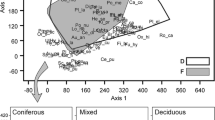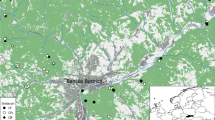Summary and conclusions
Bryophyte ecology has been little investigated in New Zealand. In the present study a northern dune area (under a dune reclamation and afforestation scheme) on the west coast, is divided into five community zones. Two of these are phases in the artificial sere leading from bare sand to exotic pine plantations. The others are seral stages in the development of the coastal forest climax.
The bryophyte flora is investigated both quantitatively and qualitatively for the terrestrial, epixylic and corticolous habitat in each of these communities.
It was found that mosses are not pioneers in the psammosere as is frequently the case in the northern hemisphere. They were secondary invaders at a late stage in the Lupinus-Psamma phase when the lupin bushes play an important part. The first bryophytes occupied epixylic stations (on logs and fallen branches). The bryophytic flora showed developmental changes in relation to the nature of the cover communities. Life form and drought tolerance of the bryophyte species are important factors. Long distance migration is by spores, but local dispersal by vegetative growth and the transportation of detached tufts is of great importance.
The size and shape of quadrat for terrestrial communities is fully investigated. It was found that shape was of no essential importance in bryocoenological methods The heavy needle litter of the pine plantations had no retarding effect on the moss carpet. Succession within the bryophyte community is from hepatics to acrocarpic and then to pleurocarpic mosses.
Corticolous mosses form a group apart and are affected by such factors as drainage patterns, nature of bark and exposure.
The bryophyte union is worked out for each cover community and three terrestrial unions and one corticolous union are recognised. It is suggested that one of the terrestrial unions is dynamic and that basically there are two distinct terrestrial unions as a climax to the bryophyte microsere; one for the Leptospermum scrub and the other for coastal forest.
My thanks are due to Prof. V. J. Chapman (Auckland University College N.Z.) for his advice and encouragement during the course of this investigation.
Résumé
Les dunes de sable très élevées sur la côte occidentale de la Nouvelle Zelande ont été fixées avec Psamma arenaria et Lupinus et plantées de Pins exotiques (Pinus radiata).
Le versant Nord d'une dune a été étudié au point de vue du développement de la végétation. Ce versant comprend une partie plantée de Pinus et une autre abandonnée à l'évolution naturelle de la végétation.
La flore bryophytique est divisée en trois catégories selon la station: Mousses vivant sur la terre nue, sur les arbres (Mousses corticoles) et sur le bois mort. Sur cette dune les Mousses n'apparaissent pas comme pionniers; elles s'installent après l'établissement de Lupinus d'abord sur des branches tombées (mortes).
Les formes biologiques des différentes Bryophytes et leur résistance contre le desséchement ont été étudiées en rapport avec les types de végétation.
Les spores des Mousses sont parfois apportées de très loin, mais dans le territoire même qui a été etudié la dispersion végétative par accroissement et par des parties détachées des touffes joue un grand rôle.
Quelques expériments avec des carrés de différente surface montrent que la forme des surfaces étudiées est de peu d'importance pour l'étude bryosociologique.
Même la litière épaisse sous le couvert du Pin ne retarde pas le développement des Mousses. Les Hépatiques apparaissent les premiers, suivies des Mousses acrocarpes et ensuite des Mousses pleurocarpes.
Les Bryophytes corticoles forment une unité à part. On a discerné en tout quatre groupements, trois groupements terrestres et un groupement corticole. Un des trois groupements terrestres constitue probablement un stage de développement tandis que deux autres semblent être des groupements terminaux permanents: stades terminaux l'un pour la brousse à Leptospermum, l'autre pour la forêt littorale.
Similar content being viewed by others
References
Allison, K. W., 1931 — Mosses & Their Habitats in the Atiamuri District, N.Z. The Bryologist. 34.
Billings, W. D. & W. B. Drew, 1938 — Bark factors affecting the Distribution of Corticolous Bryophytes. Amer. Mid. Nat. 20, (2).
Braun-Blanquet, J. — Plant Sociology (Transl. G. Fuller & H. Conrad.) McGraw-Hill. N.J., 1932.
Buchanan, J., 1873 — Notes on the Flora of the Province of Wellington, with a list of the Plants collected therein — Musci. Trans. N.Z. Inst. 6, p. 227–229.
Cain, S. A. & W. T. Penfound, 1938 — A ceretum rubri; the Red Maple Swamp Forest of Central Long Is. Amer. Mid. Nat. 19, (2) p. 390–416.
Cain, S. A. & A. J. Sharp, 1938 — Bryophytic Unions of Certain Forest Types of the Great Smoky Mountains. Amer. Mid. Nat. 20, (2), p. 249–299.
Cheeseman, T. F., 1925 — Manual of the N.Z. Flora. 2nd Ed. Govt. Printer. Wellington N.Z.
Cockayne, L., 1908 — Report on a Botanical Survey of Tongariro National Park. Govt. printer. Wellington.
, 1909 — List of Lichens and Bryophytes collected in Stewart Island. Trans. N.Z. Inst. 42, p. 320–324.
Cranwell, L. M. & L. B. Moore, 1931 — Vegetation of Maungapohatu. Rec. Auckl. Inst. & Mus. 1, (2), p. 71–80.
Cockayne, L., 1935 — Botanical notes on the Hen & Chicken Islands. Rec. Auckl. Inst. Mus. 1, (6), p. 314.
Chapman, V. J., 1944 — Study of the botanical processes concerned in the Development of the Jamaican Shore-line. J. Linn. Soc. Bot. Lond. 52, p. 407–447.
Dixon, H. N. — The Student's Handbook of British Mosses. 3rd. Ed. London, 1924.
Dixon, H. N., 1913–'28 — Studies in the Bryology of New Zealand. Bull. N.Z. Inst. 3. Pts. 1–6.
Gams, H., 1932 — In: Manual of Bryology. The Hague.
Gooding, E. G. B., 1947 — Observations on the Sand Dunes of the Barbardoes. J. Ecol. 34, (1), p. 112–125.
Lippmaa, T., 1934 — La méthode des associations unistrates et le système écologique des associations. Acta Inst. Hort. Bot. Univ. Tart. 4, (1–2), p. 1–7.
Leach, W., 1931 — The Importance of Some Mosses as Pioneers on Unstable Soils. J. Ecol. 19, p. 98–102.
Marquand, C. W. B., 1934 — In: “Scolt Head Island” (Bryophyta) Ed. J. A. Steers. Cambridge.
Martin, M. N., 1938 — Epiphytic Moss Flora of Trees in Argyll. J. Ecol. 26, p. 82–95.
Martin, W., 1943 — Mosses of Waterfall Gully, Tararua Foothills N.Z. Bull. Wellington Bot. Soc. No. 6.
, 1946 — The Moss Flora of the Arthur Pass National Park. N.Z. Trans. Roy. Soc. N.Z. 76, p. 37–57.
, 1946 — Geographic Range & Internal Distribution of the mosses Indegenous to N.Z. Trans. Roy. Soc. N.Z. 76, p. 162–184.
Moore, L. B. & G. O. K. Sainsbury, 1936 — List of Bryophytes collected on Little Barrier Island (In — Little Barrier Is. — Hamilton) N.Z. J. Sci. Techn., p. 578.
Ramaley, F., 1939 — Sand dune Vegetation of Nth. E. Colorado. Ecol. Monogr. 9, (1).
Richards, P. W., 1929 — Ecology of the Bryophytes & Lichens at Blakeney Point, Norfolk. J. Ecol. 17, p. 127–140.
Sirago, V., 1935 — Plant Unions of the swamps at the mouth of the River Emajôgi. Eng. Summary. Act. Inst. Hort. Bot. Univ. Tart. 4, (3–4), p. 1–64.
Watson, W., 1918 — Cryptogamic Vegetation of Sand Dunes of the West Coast of England. J. Ecol. 6, p. 126–143.
Zotov, V. & G. O. K. Sainsbury, 1939 — Vegetation of the Tararuas — Musci. Trans. Roy. Soc. N.Z. 68, p. 310–317.
Author information
Authors and Affiliations
Additional information
This work was carried out by the author while staying at the Auckland University College, New Zealand.
Rights and permissions
About this article
Cite this article
Robbins, R.G. Bryophyte ecology of a dune area in New Zealand. Vegetatio Acta Geobot 4, 1–31 (1952). https://doi.org/10.1007/BF00452923
Received:
Issue Date:
DOI: https://doi.org/10.1007/BF00452923




